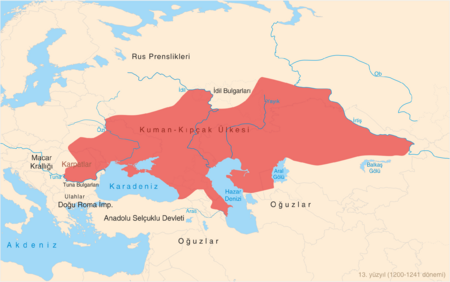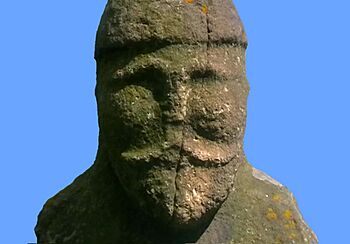Kipchaks facts for kids
The Kipchaks or Qipchaqs were a group of Turkic nomads who lived in parts of the Eurasian Steppe during the Middle Ages. They were also known as the Polovtsians.
The Kipchaks were first mentioned in the 700s. They probably lived near the Altai Mountains and then spread out over hundreds of years. First, they were part of the Kimek–Kipchak confederation, and later they joined forces with the Cumans. You could find groups of Kipchaks in places like the Pontic–Caspian steppe, China, and Siberia. Their lands, known as Cumania, were taken over by the Mongol Empire in the early 1200s.
Contents
What's in a Name?
The Kipchaks believed their name meant "hollow tree." They had a story that their first female ancestor gave birth to her son inside a hollow tree. Some experts think the name might mean "angry" or "quick-tempered." Others suggest it could be linked to "good fortune." So, the exact meaning of their name is still a bit of a mystery!
Kipchak History
In the lands where the Kipchaks lived, many different groups came together between the 1000s and 1200s. Western Kipchak tribes mixed with people like the Oghuz and Pechenegs. Eastern Kipchak tribes joined with the Kimek and Karluks. Eventually, they all became known as Kipchaks. Some groups from Mongolic backgrounds also became part of the eastern Kipchak group.
Chinese history books didn't mention the Kipchaks very often. They might talk about a general from the Kipchak tribe or give some details about the Kipchaks' homeland, their horses, or how they looked.
Early Mentions and Movements
The Kipchaks were first clearly mentioned by a Persian geographer in the 800s as a Turkic tribe in the north. It's possible they were part of the Second Turkic Khaganate in the 700s.
They likely lived in the Altai region when they were part of the Turkic Khaganate. When that empire fell apart, the Kipchaks became part of the Kimek confederation. They spread out to the Irtysh, Ishim, and Tobol rivers. In the 900s, it was said that the Kimek appointed the Kipchak king. The Kimek confederation, probably led by the Kipchaks, moved into Oghuz lands. A city called Sighnaq became an important Kipchak center.
As a result of their movements, three main Kipchak groups appeared:
- Kipchaks of the Pontic–Caspian steppe (a large grassland area).
- Kipchaks of the Syr Darya river, who were connected to the Khwarazmian dynasty.
- Kipchaks of Siberia, who later became part of the Siberian Tatars.
Joining with the Cumans
In the early 1000s, many Turkic nomads moved towards the Islamic world. It's not fully clear if the Cumans took over the Kipchaks or if they simply became the leaders of a group of Kipchak–Turkic tribes. What we do know is that these two peoples slowly joined together. From the mid-1100s onwards, the names "Cumans" and "Kipchaks" were often used to mean the same group of people.
Facing the Mongols
The Mongol Empire was a huge power. The Mongols first defeated the Alans by convincing the Kipchaks to leave them, saying they had similar languages and cultures. But then, the Kipchaks were defeated too.
Under their leader, khan Köten, many Kipchaks ran away to the Principality of Kiev (which was ruled by the Ruthenians). The Kipchaks had family ties with the Ruthenians, and Köten's son-in-law was a Ruthenian prince. The Ruthenians and Kipchaks formed an alliance against the Mongols. They met near the Dnieper River to find the Mongols. After chasing them for eight days, they met at the Battle of the Kalka River in 1223.
The Kipchaks were skilled horse archers, just like the Mongols. They acted as the first line of attack and scouts. The Mongols pretended to retreat, tricking the Ruthenian–Kipchak army into a trap. Suddenly, the Mongols appeared from behind hills and surrounded them. The fleeing Kipchaks were chased closely, and the Ruthenian camp was destroyed.
After the Mongol Invasion
When the Mongols crossed the Volga River in 1236, the nomadic Kipchaks were their main targets. Most of the defeated Kipchaks joined the Mongol army, while others fled west. Köten led 40,000 Kipchak families to Hungary. King Bela IV of Hungary gave them a safe place to live, as long as they became Christians. However, after Köten was killed, the Kipchak refugees left Hungary.
After their defeat, many Kipchaks and Cumans became soldiers for hire in Europe or were taken as slave warriors. In Egypt, many of the Mamluks (powerful soldiers who ruled Egypt) were originally Kipchaks and Cumans.
In 1239–1240, a large group of Kipchaks escaping the Mongols crossed the Danube River. This group, with over 10,000 people, searched for a long time to find a good place to settle in Thrace. The Byzantine emperor, John III Doukas Vatatzes, invited them to join his army. He settled some of them in Anatolia (modern-day Turkey) to help protect the Byzantine Empire from invaders. When the Ottomans later took over these lands, these Kipchaks mixed with other Turkic groups and became part of the Turkish people.
Another group of Kipchaks moved to Anatolia later. A Seljuk leader brought many Kipchak families from Crimea to the Western Black Sea region of Turkey.
Kipchak Language
The Kipchak–Cuman people spoke a Turkic language. The most important record of their language is the Codex Cumanicus. This is a dictionary from the late 1200s that has words in Kipchak, Cuman, and Latin. Because many Turkic-speaking Mamluks were in Egypt, dictionaries and grammar books were also made there. These books are very helpful for studying old Turkic languages.
When Armenian people moved from Crimea to the border of Poland and Ukraine in the late 1200s, they brought the Kipchak language with them. This language, called Armeno-Kipchak, was spoken by Armenian communities in places like Lviv and Kamianets-Podilskyi in what is now Ukraine.
The written form of the Cuman language died out in Hungary in the 1700s. However, the Cuman spoken in Crimea became an ancestor of the central dialect of the Crimean Tatar language.
Kipchak Religion
The Kipchaks originally practiced Tengrism, which is an ancient Turkic religion. When they lived closer to Islamic areas, some of them converted to Islam.
Around the 1000s, some Kipchaks and Cumans became Christians. This happened partly because they allied with the Georgians against Muslim groups. Many were baptized at the request of Georgian King David IV, who even married the daughter of a Kipchak Khan. By 1120, the Kipchaks had their own Christian church and clergy. After the Mongol conquest, Islam became more popular among the Kipchaks who were part of the Golden Horde.
Kipchak Culture
Kurgan Stelae
The Kipchaks are known for their balbals, which are stone statues found on ancient burial mounds called kurgans. These statues often show human figures and are an important part of their cultural legacy.
Physical Appearance
What a typical Kipchak looked like is still debated. Some historical writings describe them as having fair skin, blue eyes, and blond hair. However, other information, including studies of ancient skulls and some historical descriptions, shows that they were a very diverse group. Skulls with East Asian features are often found in Kipchak burial sites in Central Asia and Europe.
An early Chinese description from the 1200s mentioned some Kipchaks as having blond or red hair and blue or green eyes. It's important to remember that Turkic peoples were not all the same. Some groups might have had more East Asian features, while others, through mixing with different peoples like ancient Iranian-speaking nomads, might have had more European features.
Kipchak Legacy
Modern Kipchak Peoples and Languages
The modern Northwestern branch of the Turkic languages is often called the Kipchak branch. The languages in this group are mostly believed to come from the old Kipchak language. The people who speak them are sometimes called Kipchak peoples. Some of these groups include the Manavs, Karachays, Siberian Tatars, Nogays, Bashkirs, Kazakhs, Kyrgyz, Volga Tatars, and Crimean Tatars.
There is even a village named Kipchak in Crimea. In Kazakh, the name "Qypshaq" is used, and it's the name of one of the main tribes of the Kazakh people. The name Kipchak is also used as a surname in Kazakhstan. Some descendants of the Kipchaks are also found in the Bashkirian clan Qipsaq.
Notable Kipchak People
Kipchak Leaders
- Ayyub Khan (active around 1117), a Kipchak leader.
- Bačman (active 1229–1236), a Kipchak leader in the Lower Volga region.
- Köten (active 1223–1239), a very important Kipchak leader.
People with Kipchak Ancestry
- Al-Mansur Qalawun, a Mamluk sultan of Egypt (ruled 1279–1290).
- Baibars, another Mamluk sultan of Egypt (ruled 1260–1277).
- El Temür, a high-ranking official in the Chinese-Mongolian Yuan dynasty.
See also
- Manav People
- Kipchaks in Georgia
- Afghan Kypchaks
- History of the central steppe
Images for kids





